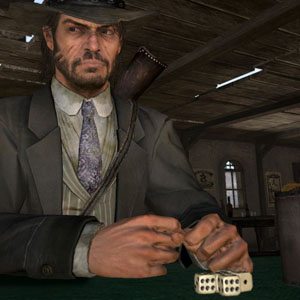
I first played Liar's Dice as an in-game gambling activity of the 2010 video game Red Dead Redemption. I had never heard of it, but quickly grasped the rules and bidding strategies.
As you can see on BGG, there are endless flavors of Liar's Dice, also known as Perudo, which try to make a "better" version of it, but in my opinion, they add fluff to a game where it isn't needed.
Thus, here are the rules to the basic version of Liar's Dice as played in Red Dead.
Liar's Dice is played by several players over the course of indeterminate number rounds. Each player starts with 5 dice. Each round, one player (and sometimes more) will discard one of their dice. When a player discards their 5th dice, they are out of the game. Rounds continue until there is a single player left with one or more dice.
Thus, the goal is to be the final player. In terms of gambling, players simply pay an ante at the beginning of the game and the winner collects the full pot.
All players shake their 5 dice in their cups and slaps them down on the table. They secretly look at their dice under their cups, then leave the cup face down over the dice so no one else can see them. The starting player states the opening bid.
A bid is a statement of how many dice of a given pip-value you think there are under everyone's cups. Bids are stated in this form: "4 Threes". This means the bidder is stating they think there are at least 4 dice under everyone's cups that are showing 3 pips. Here are a couple of examples:
"4 Threes"




"5 Fives"





Think of a bid being prefaced with "At Least...". For example "At Least 4 Threes are on the table" or "At Least 5 Fives are on the table".
On your turn, you have 3 options:
Most of the time, you'll raise the current bid from the previous player. To do this, you have three options:
- Increase the total number of dice and then you can use any pip value. For example, if the current bid is "4 Threes", you could say "5 Twos".
- Increase the face value of the dice, but keep the total number of dice the same. For example, if they current bid is "4 Threes" you could say "4 Fives" or "5 Threes".
- Or you can increase both. For example, if the current bid is "4 Threes", you could say "6 Fives".
Current Bid
"4 Threes"
   
|
Increase the Number of Dice
w/ any Pip Value
"5 Twos"
    
|
OR |
Increase the Pip-Value
w/ same number of dice
"4 Fives"
   
|
OR Increase Both
"6 Fives"
     
|
If you think the current bid from the previous player is too high, you can call a bluff. This ends the round. All players reveal their remaining dice from under cups and the dice that match the bid's pip-value are counted.
- If the number of less than the current bid, then the previous bidder looses one die because they got caught in a lie.
- Otherwise, the player who called the bluff looses one die because the bid was not a lie.
For example, the Current Bid was "4 Sixes" when Player 2 calls it a bluff.
This means that Player 2 doesn't believe there are at least 4 Sixes under everyone's cup.
|
Under Player 1's Cup
  
|
|
Under Player 2's Cup
  
|
Thus, there is a total of only 3 Sixes
  
|
Since there were only 3 Sixes, then Player 2 who called the Bluff (and was wrong) looses a die.
Everyone re-rolls their remaining dice under their cups and the next player starts the next round with a Starting Bid.
If you think the previous player's bid is the exactly right, you can call a "Spot-On". This ends the round, too. All players reveal their remaining dice from under cups and the dice that match the bid's pip-value are counted.
- If the number of dice is exact, then all players except for the one who called Spot On looses one die each.
- Otherwise, the player who called Spot On looses one die because they were wrong.
For example, the Current Bid was "4 Threes" when Player 2 calls "Spot On".
This means that Player 2 believes there are exactly 4 Threes under everyone's cup.
|
Under Player 1's Cup
 
|
|
Under Player 2's Cup
  
|
Under Player 3's Cup
  
|
|
Under Player 4's Cup
  
|
Thus, there are exactly 4 Threes
   
|
Since there were exactly 4 Threes, then the bid was Spot On and all players except for Player 2 looses a die.
Everyone re-rolls their remaining dice under their cups and the next player starts the next round with a Starting Bid.
Play continues until a single player with dice remains who is then the WINNER!
If antes were paid (i.e. betting), the winner takes the entire pot.